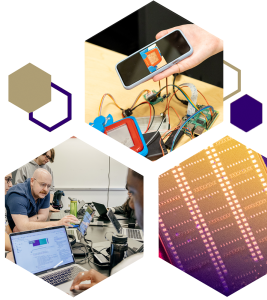Sensing and Communication Pathway
 Sensors enable us to glean insights that aren’t possible through simple human observations, and they allow us to take real-time action based on changes in surroundings. Sensing applications are used in many high impact areas of society including health, automotive, aerospace/space, robotics and the environment. For example, modern automobiles rely on hundreds of sensors for safety and efficiency. Implantable devices often incorporate biocompatible sensors that enable safe operation of a therapeutic. And scientists studying climate change can use sensing applications to monitor environmental indicators around the globe.
Sensors enable us to glean insights that aren’t possible through simple human observations, and they allow us to take real-time action based on changes in surroundings. Sensing applications are used in many high impact areas of society including health, automotive, aerospace/space, robotics and the environment. For example, modern automobiles rely on hundreds of sensors for safety and efficiency. Implantable devices often incorporate biocompatible sensors that enable safe operation of a therapeutic. And scientists studying climate change can use sensing applications to monitor environmental indicators around the globe.
In the Sensing and Communication pathway, students will develop an understanding of basic sensor design, potential applications and how wireless communication enables sensor networks.
This pathway is a good fit for students who are interested in:
- A technical area that has broad applicability and the possibility to work on consumer-centric applications
- The potential for working in many different industry sectors
FAQs
Do I need a graduate degree specializing in this area to be marketable to industry?
No. Students with a bachelor’s degree are well prepared to pursue a career in sensing and communications, but those that are interested in innovating in new areas and are interested in research should consider pursuing a master’s or doctoral degree.
What are some examples of real-world applications?
Sensing and communication plays an integral role in many parts of industry, ranging from health, automotive, aerospace/space, robotics, climate and environmental sustainability.
Does sensing and communication touch on global impact, equity and/or quality of life?
Yes. Sensing powers many high-impact areas of society, including health and the environment. Engineers also have a responsibility to develop safe and secure sensing solutions.
Areas of Impact
Sensors are integral to and drive the real-time operation of the following:
Air and Space
For example, flight control
Computing Data and Digital Technologies
For example, in data centers, Internet of Things (IoT) applications, designing protocols for cell phones and WiFi
Environmental Sustainability and Energy
For example, climate and environmental monitoring
Health and Medicine
For example, implantables and diagnostic tools
Infrastructure, Transportation, and Society
For example, traffic management
Robotics and Manufacturing
For example, drive feedback control systems
Related Career Paths
- Technology companies are increasingly investing in sensing and embedded systems: Google, Amazon, Apple, Microsoft, Meta
- Cellular and mobile communication companies: T-Mobile, AT&T, Qualcomm, etc.
- Automotive/Space/Aero: Tesla, SpaceX, Blue Origin, Boeing, Ford, GM, etc.
- MedTech: Philips, Abbott, Medtronic, etc.
- Internet of Things: Impinj, Amazon, Samsung, etc.
- Robotics: Amazon, KUKA, etc.
On-the-job tasks for graduates with a focus in Sensing and Communication include:
- Testing, verifying and calibrating wireless communication systems across the stack.
- Designing networking equipment (both wired and wireless) and protocols from antennas, as well as radio frequency (RF) chips to routers, and even large internet exchanges.
- Developing sensing systems for industrial applications, such as supply chain, aeronautics, medical and underwater applications.
Sensing and Communication Courses
When planning for courses, review projected course offerings here and be sure to check all course prerequisites (course titles below link to the catalog course description, which includes prerequisite information).
These courses are suggested for those following the Sensing and Communication pathway but are not required to complete the BSECE degree program:
EE 371 — Design of Digital Circuits and Systems
This course provides a theoretical background and practical experience with tools and techniques for modeling complex digital systems, using the Verilog hardware description language. Students will learn how to maintain signal integrity, manage power consumption and ensure robust intra- and inter-system communication.
EE 419 — Introduction to Computer-Communication Networks
This is a fundamental class to understand advanced communications techniques that are often critical in sensor systems.
EE 474 — Introduction to Embedded Systems
Computers are all around us, from the smartphones in our pocket, to the control systems in cars, planes, and robots, to many other systems where a microprocessor is embedded into a system it controls. This course takes a practical approach to introducing the hardware and software components needed to build an embedded system from the ground up.
Capstone
EE 475 — Embedded Systems Capstone
In this capstone class, students will work in teams to apply knowledge they gained in EE 474, Introduction to Embedded Systems, and from other previous ECE courses to prototype and build a substantial project that mixes hardware and embedded software and communication. Students often build projects in specific application areas that include but are not limited to health, robotics, Internet of Things (IoT), and smart systems. Students will also hear from experts in embedded systems to learn about emerging platforms, trends and job opportunities/prospects.
EE 497 (winter quarter) and EE 498 (spring quarter) — Engineering Entrepreneurial Capstone (ENGINE)
The Engineering Entrepreneurial Capstone program (ENGINE) is the culmination of a student’s electrical and computer engineering education at UW ECE. The program provides a unique opportunity for students to develop skills in collaborative systems engineering, project management, and most importantly, working in teams on real-world problems from industry-sponsored projects. The program is overseen by UW ECE faculty and students are guided by practicing engineers. The course culminates in a showcase of student projects, which is attended by industry sponsors and held at the end of spring quarter every year.
Crossing Paths
Students studying Sensing and Communication consider the following pathways:

